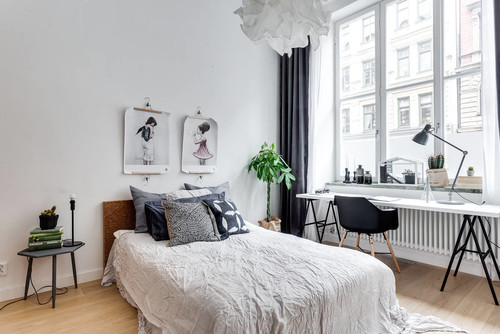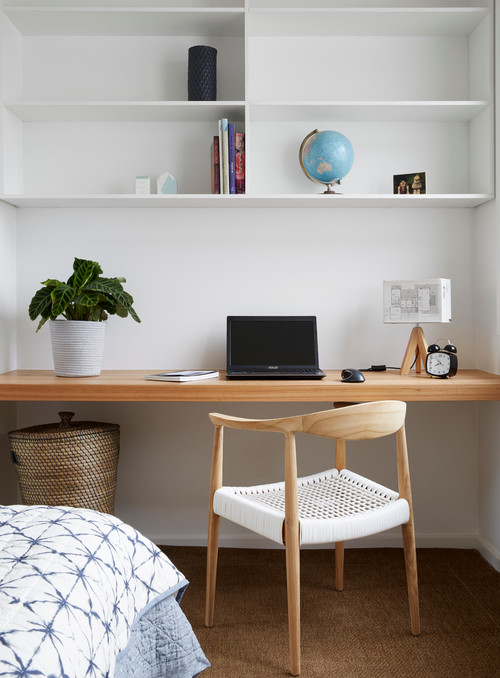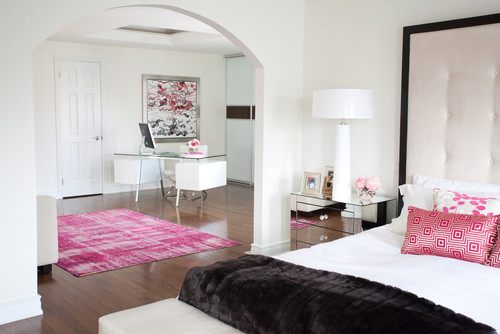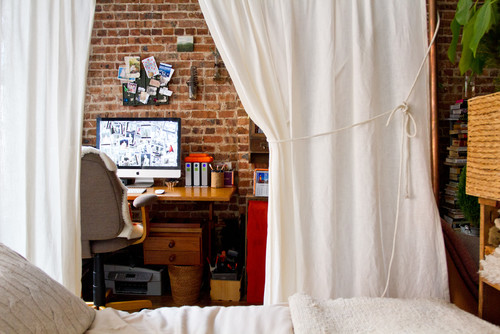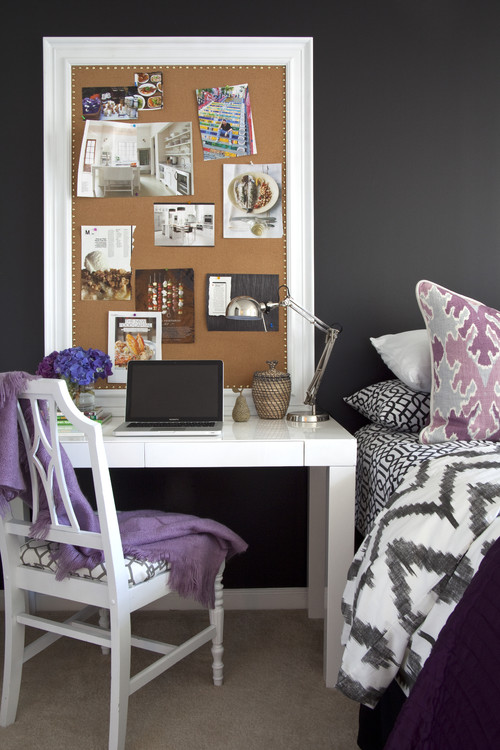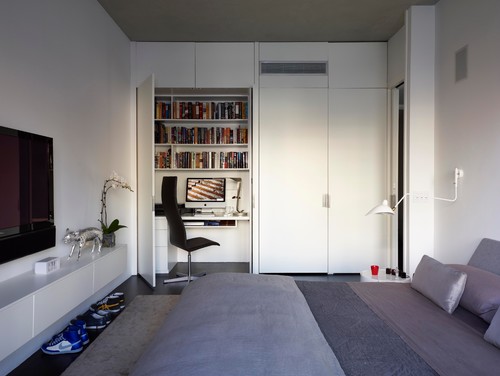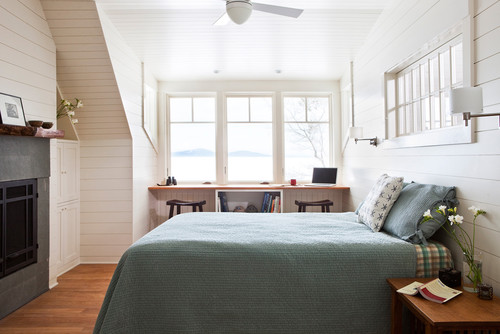Successful Office-Bedroom Combos

By Melissa Cowan
Wake up, get dressed (or not), make coffee and head over to do some work at your desk. Sounds like heaven, right? There are, without a doubt, perks to working from home: no commute time, far fewer interruptions and more control over your work environment, to name a few. But it also brings with it the need to make conscious decisions about how you work most efficiently, and how your workspace can help.
Probably most of us would choose a separate office over an office-bedroom combo. But when that’s not possible, creating a dedicated workspace in a bedroom can be the next best thing. For it to be as conducive to productivity as possible, planning is required. Here are some things to keep in mind when planning or setting up your bedroom office.
Have an outward-facing desk. Facing your desk toward a wall or window is a smart move. By having your back to the bed, you’ll be less distracted by thoughts of sweet slumber when you’re trying to work.
Trestle tables look beautiful and are good for wide spaces but don’t offer the same storage as most other desks. If the majority of your work and documents are online, then you probably won’t need much storage, though.
Get the chair right. The chair you sit in while you work makes a big difference to your health and comfort. If you won’t be using the chair too frequently, you have more scope to have aesthetics as a primary concern. Either way, you’ll want to get a supportive and comfortable chair, preferably of the well-designed ergonomic variety.
Separate the areas. It’s important to keep a distinction between work and relaxation areas. If you have the room, keeping physical space between your bed and desk is an easy solution.
There are also strategies you can use to create a distinction between work and play. This depends on what works best for you, but keeping a regular start and finish time can help, as can avoiding checking emails after hours.
Using a curtain or screen is another effective way to separate work and sleep areas. Closing the curtain when you’re done is a direct way to signify the end of the workday. The renter of the space pictured here installed the curtain with the help of her landlord, by affixing a long copper pole to the floor and ceiling with plumbing anchors, adding an Ikea curtain wire and then stringing on some curtains.
Consider multipurpose furniture. If you’re working with a really limited space, you may want to use your desk as a bedside table. This can be risky in terms of the two parts of your life merging, however. Small things you can do to help include closing your laptop or turning off your computer when you’re done, and removing all papers and work-related items until you use it as a workspace again. I love the use of a corkboard as an inspiration board too.
Hide it in a closet. Putting your desk and computer in a closet that can closed when you’re done is a fabulous idea. Not only can you shut the door when you’re done with work, but it also means that the office won’t have a visual impact on the rest of the bedroom.
Tie in the decor. Although your aim may be to separate the two areas, the fact is that your workspace will have an impact on the feel and aesthetics of your bedroom. Opting for a desk and chair that don’t contrast too heavily with the rest of the room will help create a sense of cohesion. Essentially the idea is to create a sense of unity with the aesthetics, but also some separation between work and rest for your sanity!
Tying in colors from the rest of the room through art placed above the desk or a carefully selected ornament will help to unify the flow of the room. It will also help provide vibrancy and inspiration in your work environment.
Use a Murphy bed. Murphy beds can work well for a lot of small spaces with different functions, but especially for a bedroom office. Putting the bed up and into the wall makes the space feel like a dedicated office rather than a combined space. Putting the bed away will also help you avoid using your laptop in bed.
Ensure you have enough storage. The amount of paper files, stationery and other work-related bits and pieces you need will obviously depend on what type of work you’re doing. If you want to be on the minimalist side, you could scan all your important documents to your computer and get rid of the originals (only after you have backed up — to several locations). If paperwork is unavoidable, have a combination of shelves and file storage to keep everything organized and easy to locate.
Have adequate lighting. There’s nothing more demoralizing than trying to work in a dark space, or one with fluorescent lighting. The right lighting is important for your eyes, productivity and morale. If there’s a window in your bedroom, place your desk near it and make the best use of beautiful natural light by keeping the blinds fully open, or half open if there is a glare.
If there’s no window, opt for bright but warm overhead lights, desk lamps or both. You’ll want to avoid lighting that causes a glare on your computer screen. Task lighting behind the screen can be one way to avoid glare.
Think about who’ll be using the space. Will it be just you using the workspace? If so, set it up solely according to your own preferences and needs. If, however, you and a partner or friend will be sharing the workspace, you’ll need to consider his or her needs as well. If you will ever be using the workspace with someone else at the same time, make sure it’s not going to be too cramped. If there is adequate space, separate the two areas and chairs as much as possible. And make sure you talk about how you can avoid distracting or annoying each other while you work.
Play with the bed level. The sunken bed pictured here looks super cool and helps to create that important separation between work and rest zones. If the bed isn’t level with the desk, the room will feel less cramped.
Original article: Houzz
Read original article here.
Original article: The Province
Read original aricle here.

